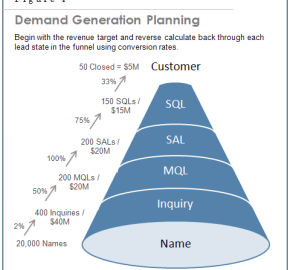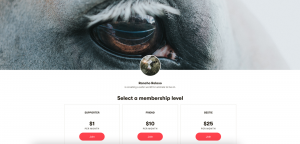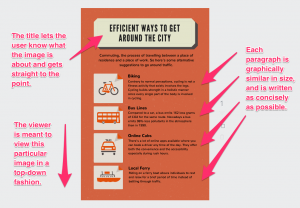How many leads do you need, exactly? Don’t know? It all starts with the funnel model. If you are in a startup and your product is ready to sell, you need to model your sales process to understand how much to invest in your sales team and marketing budget. The model also acts as a set of guideposts that will let you know if you are on track to hit your numbers. Learn how to reverse calculate from your revenue target back up through the funnel to visitors on your website. – TM
To effectively drive demand for a business, the marketing organization must have a concrete target number of leads in each state. The easiest way to calculate these numbers is to start with your revenue target and then work backward up the funnel. Using known or estimated conversion rates and the average sale size, you will reverse calculate how many sales accepted leads (SALs) and sales qualified leads (SQLs) you need to produce the required number of customers. Likewise, you will calculate how many marketing qualified leads (MQLs) you need to generate the required number of SQLs, and how many inquiries you need to produce your target number of MQLs.
There is an additional important consideration. Make certain you understand how much new revenue marketing is responsible for generating. Marketing is often not responsible for generating 100 percent of qualified leads. For example, if an organization’s revenue includes recurring annual fees, such as support and maintenance for software, or subscription renewals for telecommunications services, then sales or customer service may be responsible for handling this, and they probably will not require marketing assistance for demand generation (unless there is an attrition problem, in which case a marketing program aimed at retention will be needed).
If you work with a dedicated direct sales force, sales management typically will assume responsibility for generating 15 to 50 percent of the pipeline. These leads are sometimes referred to as sales-generated leads, or SGLs. This pipeline comes from repeat business from existing customers, pipeline carried over from previous quarters, or a desire on the part of sales leadership to make their salespeople prospect for new business. If you don’t have a dedicated sales force, then you may be expected to generate 100 percent of the pipeline.
After you have established your revenue target and percentage of qualified leads marketing needs to generate, you can start your calculations. If you do not have historical conversion data to rely on, you can obtain conversion rates from a number of marketing research firms, including SiriusDecisions and Forrester Research.
Let’s say you have a new revenue target of $ 10 million. Sales will take responsibility for half of this amount from the existing pipeline and by prospecting from their own contacts. So, marketing needs to generate the other half, or $ 5 million. To keep the math simple, our product will sell for the nonnegotiable price of $ 100,000. The funnel figure below illustrates our process. I’ve flipped the funnel upside down to emphasize the reverse process I use.
There are six steps to demand generation planning:
- Step 1: Start with our target of $ 5 million.
- Step 2: Divide this total by the price of an individual product ($ 100,000) to determine the number of customers we need. 5,000,000 ÷ 100,000 = 50 closed opportunities.
- Step 3: Calculate the total number of opportunities, or SQLs, we need to generate fifty closed opportunities. Our reps believe they can close one out of every three deals. Thus, 50 × 3 = 150 SQLs.
- Step 4: Calculate the number of MQLs needed to provide sales with 150 SQLs. Having worked with this team for a while, we know that sales accepts all of our MQLs. So, the number of SALs and MQLs will be the same. We also know that sales qualifies approximately three in every four MQLs (75 percent). 150 ÷ 0.75 = 200. So, we need 200 MQLs to generate 150 SQLs.
- Step 5: We have to determine how many inquiries we need to produce two hundred MQLs. We know that about 50 percent of our inquiries convert to MQLs. 200 ÷ 0.50 = 400. So, we need four hundred inquiries.
- Step 6: Our final step—and potentially the most discouraging—is to factor in the response rate for direct e-mail. In our case, this rate is 2 percent. 400 ÷ 0.02 = 20,000. Thus, to obtain four hundred inquiries, we need twenty thousand names.
The best sources for data on conversion percentages are your market nous, results from prior activities, your sales team, and firms that track these statistics by surveying sales and marketing teams, such as SiriusDecisions and MarketingSherpa. Make sure to be a realist and not a Pollyanna. Your sales price should be your average sales price—reflecting typical discounts, not your suggested list price. When in doubt, be conservative by picking lower conversion rates. Keep in mind that conversion rates are usually much higher for existing customers, so treat them well and market new products to them whenever you can. If your CFO wants to know why marketing needs so much money, show him or her the funnel, and explain the costs associated with buying or acquiring twenty thousand names.
Finally, make certain you have enough opportunities to achieve your revenue number. Marketers refer to the required ratio of opportunities to target revenue as pipeline coverage. A coverage ratio of 3:1 is typical (this is why we multiplied closed opportunities by three in step 3 above). Consequently, when you run a “pipeline coverage report,” which you should pull from your marketing automation system on a regular basis, a ratio of 2:1 would not provide sufficient coverage to achieve your number, whereas 4:1 would provide more than you need. When the coverage is too low, you should invest additional money to raise the number until you achieve your target. Conversely, when the coverage is too high, then you should consider allocating a greater share of your budget to other marketing activities (or, you can suggest raising the revenue forecast).
Business & Finance Articles on Business 2 Community(216)









